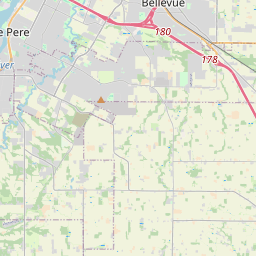St. Joseph's Church
Historical marker location:
E3289 County Road G, Norman, Wisconsin
( Marker is on County Road G west of Norman Road, on the left when traveling west.)
Marker installed: 2010







© OpenStreetMap contributors
Loading...
Searching for other points of interest within 3 miles of this location.The House on the Rock, located in Spring Green, Wisconsin, is a unique tourist attraction that features a bizarre collection of antiques, automata, and other oddities. It was built by architect Alex Jordan Jr. in the 1940s and 1950s.
About Kewaunee County
Kewaunee County Timeline
Kewaunee County, located in northeastern Wisconsin, has a rich history that dates back thousands of years to when it was inhabited by Native American tribes. The region was originally home to the Menominee, Potawatomi, and Winnebago tribes who relied on the natural resources of the area for their livelihoods. European exploration and settlement began in the 17th century, with French fur traders establishing a presence in the area.
In the early 19th century, the United States government acquired the region through treaties with the Native American tribes, opening the way for European-American settlement. The first permanent settlers arrived in the 1830s, primarily of German and Irish descent. The town of Kewanee, later renamed Kewaunee, was founded in 1852 and became the county seat in 1858.
The county's economy was initially fueled by agriculture, particularly dairy farming. Kewaunee County quickly developed as a major producer of milk, cheese, and other dairy products. The area's rich soil and temperate climate were favorable for agricultural activities, leading to the establishment of numerous family farms and creameries.
In the 20th century, the economy diversified with the growth of the manufacturing industry. Shipbuilding, aluminum production, and other manufacturing operations flourished, providing additional employment opportunities for the county's residents. Today, Kewaunee County continues to be known for its scenic landscapes, agricultural heritage, and industrial contributions.
In the early 19th century, the United States government acquired the region through treaties with the Native American tribes, opening the way for European-American settlement. The first permanent settlers arrived in the 1830s, primarily of German and Irish descent. The town of Kewanee, later renamed Kewaunee, was founded in 1852 and became the county seat in 1858.
The county's economy was initially fueled by agriculture, particularly dairy farming. Kewaunee County quickly developed as a major producer of milk, cheese, and other dairy products. The area's rich soil and temperate climate were favorable for agricultural activities, leading to the establishment of numerous family farms and creameries.
In the 20th century, the economy diversified with the growth of the manufacturing industry. Shipbuilding, aluminum production, and other manufacturing operations flourished, providing additional employment opportunities for the county's residents. Today, Kewaunee County continues to be known for its scenic landscapes, agricultural heritage, and industrial contributions.
Kewaunee County Timeline
This timeline provides a concise overview of the key events in the history of Kewaunee County, Wisconsin.
- 1852: Kewaunee County is established and named after the Kewaunee River.
- 1855: The first courthouse is built in Kewaunee, the county seat.
- 1860: Kewaunee County's population reaches over 7,000 people.
- 1881: The Ahnapee & Western Railway is completed, providing transportation for goods and people.
- 1894: The Kewaunee Pierhead Lighthouse is constructed to guide ships into Kewaunee harbor.
- 1911: The Kewaunee Nuclear Power Plant is built, becoming the county's largest employer.
- 1926: The Kewaunee County Fair is established, showcasing agricultural and entertainment exhibits.
- 1949: The Kewaunee County Historical Society is founded to preserve the county's history.
- 1973: The Kewaunee Nuclear Power Plant begins operations, generating electricity for the region.
- 1995: The Kewaunee County Jail Museum opens, offering visitors a glimpse into the county's past.